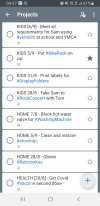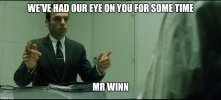Murray
Registered
For most of my GTD history I have not systematically linked actions to projects. However last year (after reading the setup guide) I started experimenting with using hashtags in mstodo for this purpose and I have found that for me, once I was doing it consistently it felt easy and natural, and it supports my process by helping me clarify what the project is.
Here are two screen shots from my phone - the first showing a section of my project list, each with a tag. The second showing what I see if I click on the tag for the #BikeRack project. Likewise if I were looking at the action list (in this case Waiting For list) I could click on the tag to be taken to the project.
Feels quick and easy and worth it for me, but I wouldn't try to force it on anyone else. I like how it means I have to boil the project outcome down to a word or two for the tag (even though the full project title is longer)
(By the way, the dates are not due dates - they are the last date on which I added a new next action. I add these manually and again, wouldn't recommend that additional processing step for everyone.)
Here are two screen shots from my phone - the first showing a section of my project list, each with a tag. The second showing what I see if I click on the tag for the #BikeRack project. Likewise if I were looking at the action list (in this case Waiting For list) I could click on the tag to be taken to the project.
Feels quick and easy and worth it for me, but I wouldn't try to force it on anyone else. I like how it means I have to boil the project outcome down to a word or two for the tag (even though the full project title is longer)
(By the way, the dates are not due dates - they are the last date on which I added a new next action. I add these manually and again, wouldn't recommend that additional processing step for everyone.)
Attachments
Last edited:



